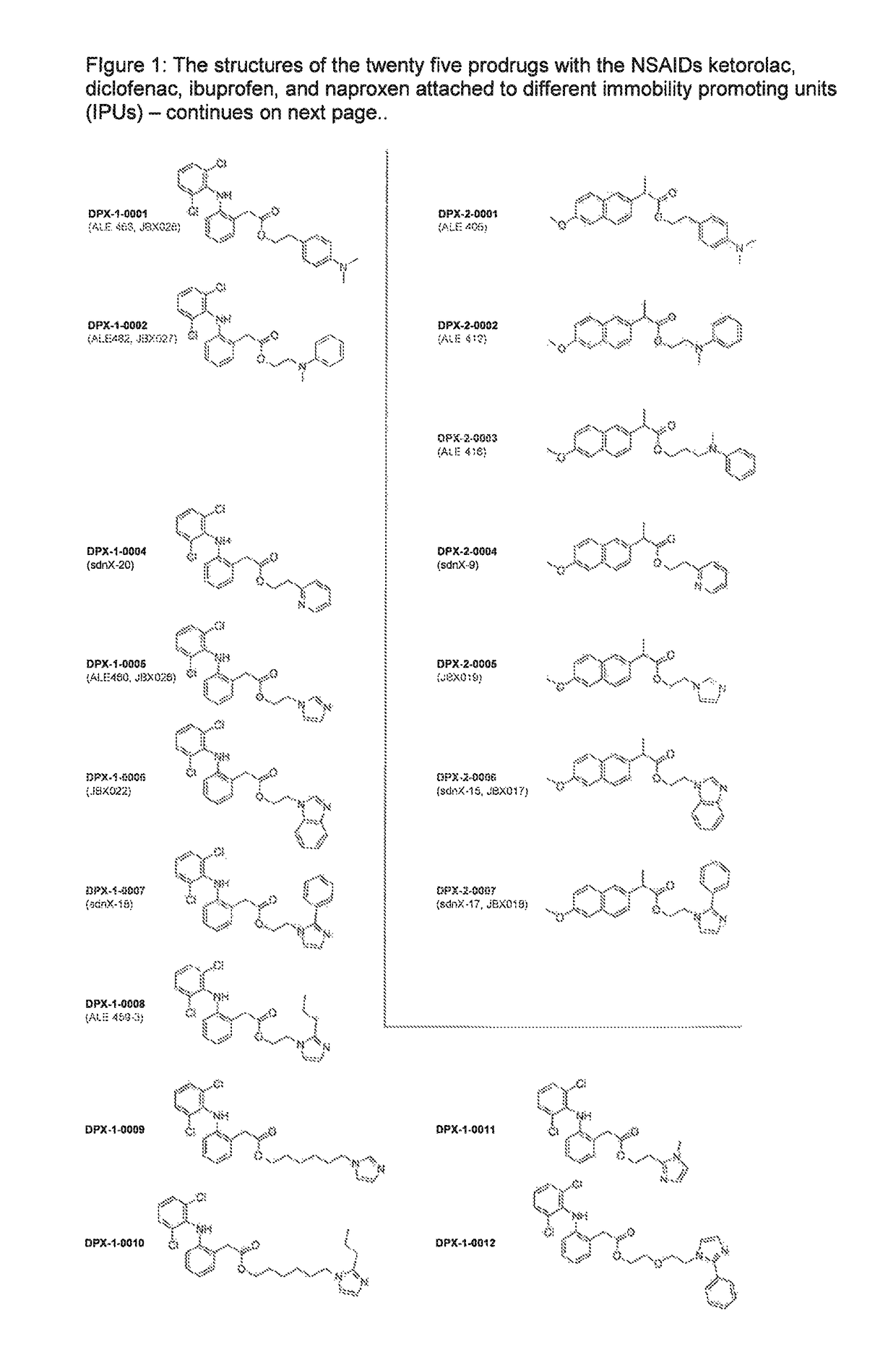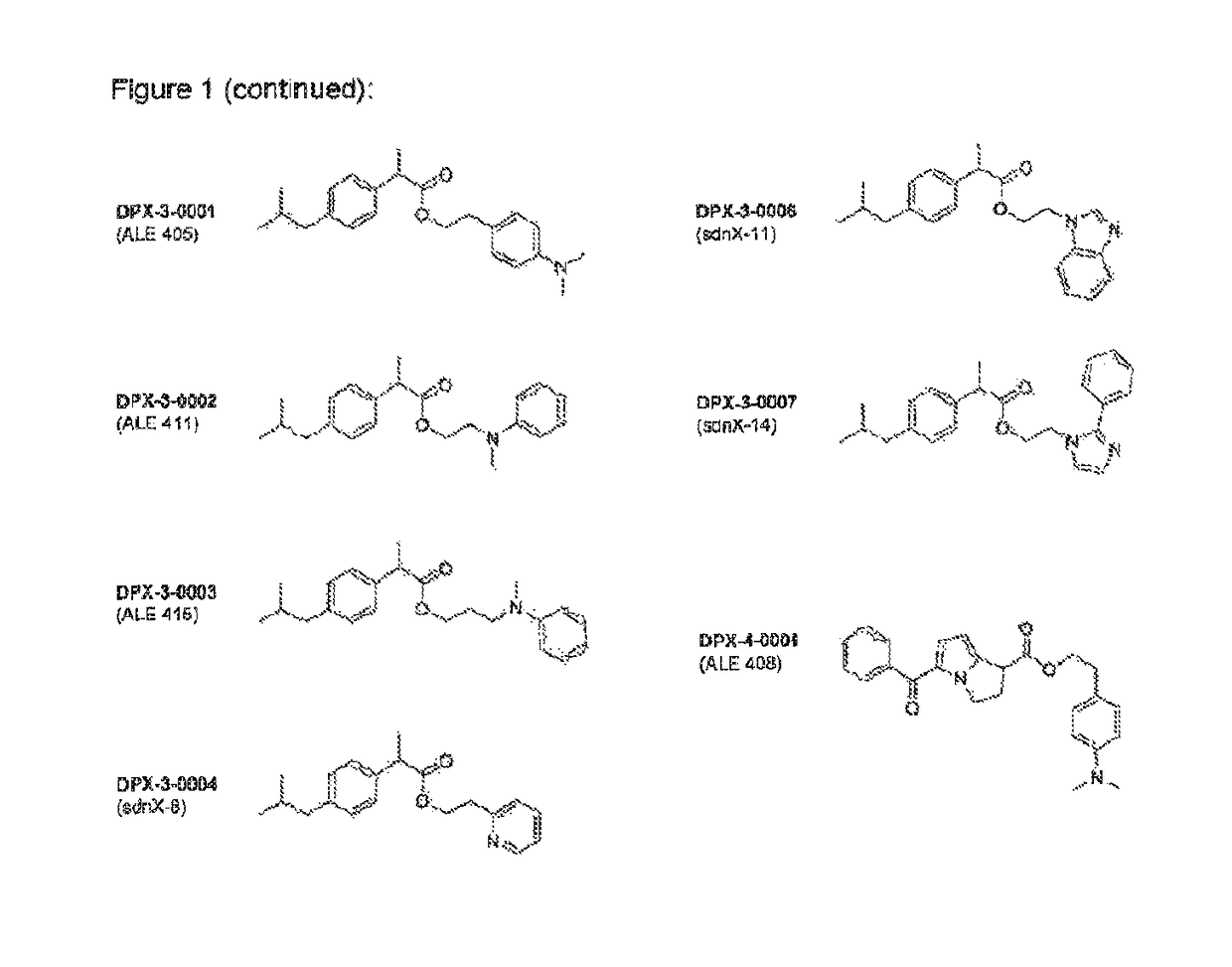Prodrugs of non-steroid anti-inflammatory agents (NSAIDS)
a technology of anti-inflammatory agents and prodrugs, which is applied in the field of new drugs, can solve the problems of difficult site-specific treatment of e.g. inflammation with nsaids, limiting the effective dose at the injured or inflamed site, and arthroscopic procedures produce pain and inflammation. , to achieve the effect of convenient formulation and sterilisation
- Summary
- Abstract
- Description
- Claims
- Application Information
AI Technical Summary
Benefits of technology
Problems solved by technology
Method used
Image
Examples
example 1
DPX-1-0001 (ALE463)
4-(dimethylamino)phenethyl 2-(2-(2,6-dichlorophenylamino)phenyl)acetate
[0088]2-(4-(dimethylamino)phenyl)ethanol (3.3 mmol, 0.55 g), and Dichlofenac (3.3 mmol, 0.99 g) was suspended in dichloromethane (30 mL) under N2 and Dicyclohexylcarbodiimid (6.6 mmol, 1.36 g), 4-Dimethylaminopyridine (0.33 mmol, 36 mg) was added. The mixture was stirred overnight before being poured into sat. NH4Cl (100 mL) and extracted with dichloromethane (4×50 mL). Drying, filtration and evaporation gave 2.4 g crude material which was purified by Flash Chromatography using EtOAc and Heptanes as eluent giving 0.65 g (43%) of the desired compound. 1H NMR (400 MHz, DMSO-d6) 7.52 (d, J=8.03 Hz, 4H), 7.13-7.24 (m, 4H), 7.04-7.10 (m, 2H), 6.93-7.02 (m, 5H), 6.85 (dt, J=1.25, 7.40 Hz, 2H), 6.58-6.63 (m, 4H), 6.26 (d, J=7.53 Hz, 1H), 4.21 (t, J=7.03 Hz, 4H), 3.78 (s, 2H), 2.82 (s, 11H), 2.77 (t, J=7.03 Hz, 4H) 13C NMR (400 MHz, DMSO-d6) 171.40, 137.07, 130.90, 129.28, 125.86, 123.20, 112.53, 65.51...
example 2
DPX-1-0002 (ALE 482)
2-(methyl(phenyl)amino)ethyl 2-(2-(2,6-dichlorophenylamino)phenyl)acetate
[0089]Using an identical procedure as described for DPX-1-0001:
[0090]2-(methyl(phenyl)amino)ethanol (3.3 mmol, 0.50 g), Dichlofenac (3.3 mmol, 0.99 g), Dichclohexylcarbodiimid (6.6 mmol, 1.36 g), 4-Dimethylaminopyridine (0.3 mmol, 36 mg) and dichloromethane (30 mL). Crude yield: 1.4 g; yield after Flash Chromatography using ethyl acetate and heptanes as eluent: 0.83 g (59%). 1H NMR (400 MHz, DMSO-d6) d 7.52 (d, J=8.28 Hz, 3H), 7.20 (t, J=8.16 Hz, 2H), 7.10-7.15 (m, 4H), 7.05 (dt, J=1.51, 7.78 Hz, 2H), 6.97 (s, 1H), 6.83 (dt, J=1.25, 7.40 Hz, 2H), 6.66-6.72 (m, 3H), 6.56-6.63 (m, 2H), 6.25 (d, J=8.03 Hz, 1H), 4.24 (t, J=5.77 Hz, 3H), 3.74 (s, 3H), 3.58 (t, J=5.77 Hz, 3H), 2.83 (s, 5H). 13C NMR (400 MHz, DMSO-d6) δ 171.43, 148.71, 142.81, 137.06, 129.13, 128.94, 127.71, 123.02, 115.89, 111.98, 61.90, 50.24, 38.15, 37.02, 31.23, 28.34, 22.07,
Methanesulfonate salt of DPX-1-0002.
[0091]Methanesulf...
example 3
DPX-1-0004 (sdnX-20)
2-(pyridin-2-yl)ethyl 2-(2-((2,6-dichlorophenyl)amino)phenyl)acetate
[0092]Using an identical procedure as described for DPX-1-0001:
[0093]2-(pyridin-2-yl)ethanol (37.7 mmol, 4.65 g), Dichlofenac (9.43 mmol, 3.0 g), 4-Dimethylaminopyridin (0.3 mmol, 35 mg), 1-Ethyl-3-(3-dimethylaminopropyl) carbodiimide-HCl (11.32 mmol, 2.17 g), Dichloromethane (15 mL) and Dimethylformamide (10 mL). Yield after Flash Chromatography using ethyl acetate and heptanes as eluent: 1.67 g. The solid HCl-salt was prepared by passing a stream of HCl through an ethereal solution of the product. 1H NMR (CDCl3) 3.3-3.7 (m, 4H), 4.58 (br s, 2H), 6.24-7.30 (m, 8H), 7.60 (br s, 1H), 7.97 (br s, 1H), 8.57 (br s, 1H). 13C (CDCl3): 13.76, 22.29, 25.24, 28.61, 30.62, 31.47, 32.39, 38.03, 62.30, 67.58, 111.37, 121.53, 123.17, 124.30, 124.77, 127.39, 127.81, 128.51, 128.59, 129.42, 130.78, 136.85, 140.77, 142.26, 145.15, 153.05.
PUM
| Property | Measurement | Unit |
|---|---|---|
| pKa | aaaaa | aaaaa |
| pKa | aaaaa | aaaaa |
| pH | aaaaa | aaaaa |
Abstract
Description
Claims
Application Information
 Login to View More
Login to View More - R&D
- Intellectual Property
- Life Sciences
- Materials
- Tech Scout
- Unparalleled Data Quality
- Higher Quality Content
- 60% Fewer Hallucinations
Browse by: Latest US Patents, China's latest patents, Technical Efficacy Thesaurus, Application Domain, Technology Topic, Popular Technical Reports.
© 2025 PatSnap. All rights reserved.Legal|Privacy policy|Modern Slavery Act Transparency Statement|Sitemap|About US| Contact US: help@patsnap.com



